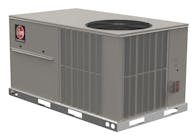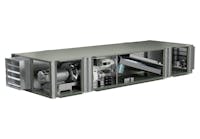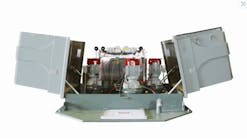In January, the American Society of Heating, Refrigerating and Air-Conditioning Engineers (ASHRAE) standards committee responsible for reviewing and improving ANSI/ASHRAE Standard 52.2, Method of Testing General Ventilation Air Cleaning Devices for Removal Efficiency by Particle Size, approved two changes to the document's testing and reporting methods, both of which will take effect when the revised standard is published this fall:
-
Addendum B, which mandates calculation of arrestance for filters with Minimum Efficiency Reporting Values (MERVs) of 1 to 4 and arrestance and dust-holding capacity for filters with MERVs of 5 to 16. By incorporating arrestance and dust-holding capacity, the addendum makes ASHRAE Standard 52.1-1992, Gravimetric and Dust Spot Procedures for Testing Air Cleaning Devices Used in General Ventilation for Removing Particulate Matter, obsolete.
-
Appendix J, which replaces the non-mandatory filter-conditioning step of 30 grams of dust loading with a potassium-chloride (KCl) conditioning method that closely mimics the aerosol-particle size distribution air filters commonly face when operated under “real-life” conditions. This provides an additional value, MERV-A, which can be used to better ensure performance over a filter's life.
According to the 1999 version of the standard: “Some fibrous-media air filters have electrostatic charges that may either be natural or imposed upon the media during manufacturing. Such filters may demonstrate high efficiency when clean and drop in efficiency during their actual use cycle. The initial conditioning step of the dust-loading procedure described in this standard may affect the efficiency of the filter, but not as much as would be observed in actual service. Therefore, the minimum efficiency during test may be higher than that achieved during actual use.”
With the KCl conditioning method, such discrepancies will be evident to specifiers and users.
Filters using fine-fiber media operate on mechanical principles of particle removal, including impingement and diffusion. They do not lose efficiency over time, and, thus, their MERVs typically are the same as their MERV-As.
SIGNIFICANCE OF THE CHANGES
With Addendum B, particle size vs. efficiency, arrestance, and dust-holding capacity are combined into one filter-testing standard. MERV will be the only criteria for selecting a filter for a particular application.
The conditioning step in Appendix J will allow manufacturers to show results from two test procedures (e.g., MERV 14 and MERV-11-A for the same filter) on reports and in product literature. If a filter's MERV is different than its MERV-A, it will be safe to assume that the MERV-A is closer to the efficiency of the filter in real-life application.
With recent independent studies1,2,3 showing that sub-micron particles are a detriment to health, the selection of air filters based on particle size is becoming critical to protecting the health of building occupants.
EVALUATING AIR-FILTER PRODUCTS
Two trends are dramatically changing air-filter selection from just a few years ago. They are:
-
Despite regulations aimed at reducing pollution, small-particle emissions as a byproduct of the combustion of fossil fuels continue to increase at alarming rates, as the number of vehicles in operation has increased 20 percent over the last 10 years. Additionally, a 2006 study1 determined that 30 percent of the pollution in the United States is “imported” from newly industrialized countries.
-
Numerous studies are detailing cases in which small particles (less than 2.5 microns) posed significant health risks. Very small particles (much less than 1 micron) can find their way deep into the lungs and cause damage. Even particles in the 1-micron size range can find their way into the bloodstream. Previously, only larger airborne particles were thought to be of concern, posing primarily an upper-respiratory threat.
WHAT TO LOOK FOR
MERV 1 through MERV 5 filters are used primarily to protect equipment. In such cases, MERV, dust-holding capacity, and arrestance should be part of a user's/specifier's criteria. The higher the MERV, the better the performance. MERV 6 through MERV 16 filters are used to protect not only equipment, but building occupants.
When comparing air filters, look at both the MERVs and MERV-As. These data should be included in the product literature. Also, the manufacturer(s) should be able to provide test reports verifying the Appendix J conditioning step.
In a typical atmospheric-air sample, the most common airborne-particle size is about 0.4 micron. To protect building occupants, choose a filter that is highly efficient in capturing particles of that size. For a commercial building, that would be a MERV 13/MERV-13-A filter; for a medical facility, it would be a MERV 14/MERV-14-A filter.
For critical applications, choose air filters utilizing a fine-fiber medium not dependent on an electrostatic charge. The efficiency of such filters will be maintained over time, unlike that of filters utilizing a coarse-fiber medium dependent on an electrostatic charge, which will dissipate (Figure 1).
Examine a filter's construction and configuration (shape of the media pack, stability of the pleats, pleat separation, etc.) to determine the amount of media area being used effectively. Generally, the greater the media area, the longer the life and the lower the energy use of a filter.
Ask a filter's manufacturer for actual historical pressure-drop-performance data. Filter pressure-drop rise is not linear, and superior-performing filters offer a longer loading curve. This translates to improved airflow and significant energy savings over the life of a filter.
Always consider the total cost of ownership, including initial product cost, life-cycle energy cost, labor to install and remove, and disposal expense.
STANDARD 52.2 AND LEED
The U.S. Green Building Council's (USGBC's) Leadership in Energy and Environmental Design (LEED) Green Building Rating System recognizes MERV. After the revised Standard 52.2 is presented to the USGBC, MERV-A is expected to be recognized as well.
REFERENCES
-
Laden, F., Schwartz, J., Speizer, F.E., & Dockery, D.W. (2006). Reduction in fine particulate air pollution and mortality — extended follow-up of the Harvard Six Cities study. American Journal of Respiratory and Critical Care Medicine, 173, 667-672.
-
Samet, J.M., Dominici, F., Curriero, F.C., Coursac, I., & Zeger, S.L. (2000). Fine particulate air pollution and mortality in 20 U.S. cities, 1987-1994. New England Journal of Medicine, 343, 1742-1749.
-
Bell, M.L., et al. (2007). Climate change, ambient ozone, and health in 50 US cities. Climatic Change, 82, 61-76.
-
Raynor, P.C., & Chae, S.J. (2003, March). Dust loading on electrostatically charged filters in a standard test and a real HVAC system. Filtration & Separation, pp. 35-39.
-
Raynor, P.C., & Chae, S.J. (2004). The long-term performance of electrically charged filters in a ventilation system. Journal of Occupational and Environmental Hygiene, 1, 463-471.
For past HPAC Engineering feature articles, visit www.hpac.com.
With more than 30 years of HVAC- and air-filtration-industry experience, Charles Seyffer is market and technical-services manager for Camfil Farr. In addition to being responsible for all technical publications and literature published in North America by Camfil Farr, he lectures on the removal of airborne particulate and gaseous contaminants. An active member of the American Society of Heating, Refrigerating and Air-Conditioning Engineers (ASHRAE), he serves on ASHRAE Technical Committee 2.4, Particulate Air Contaminants and Particulate Contaminant Removal Equipment, the cognizant committee for ANSI/ASHRAE Standard 52.2, Method of Testing General Ventilation Air Cleaning Devices for Removal Efficiency by Particle Size. He can be contacted at [email protected].








